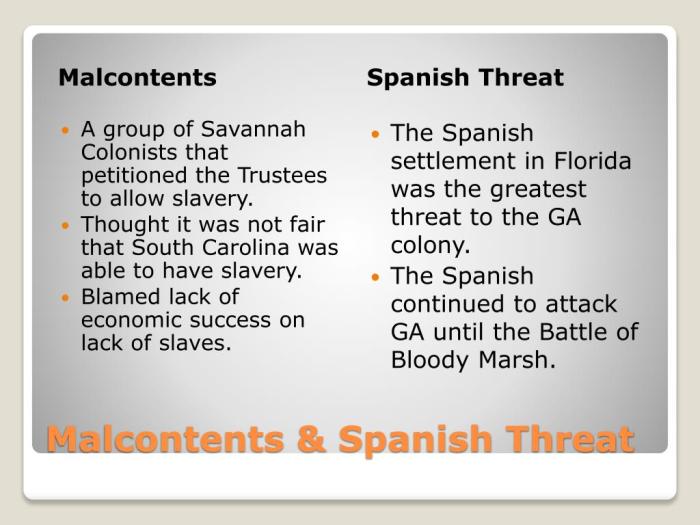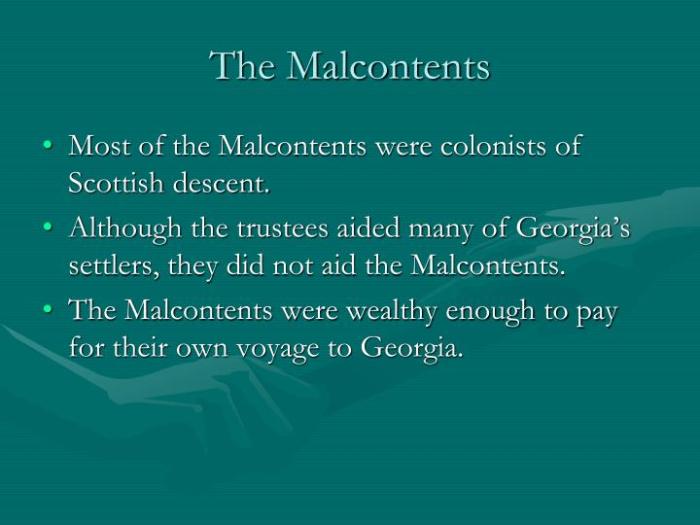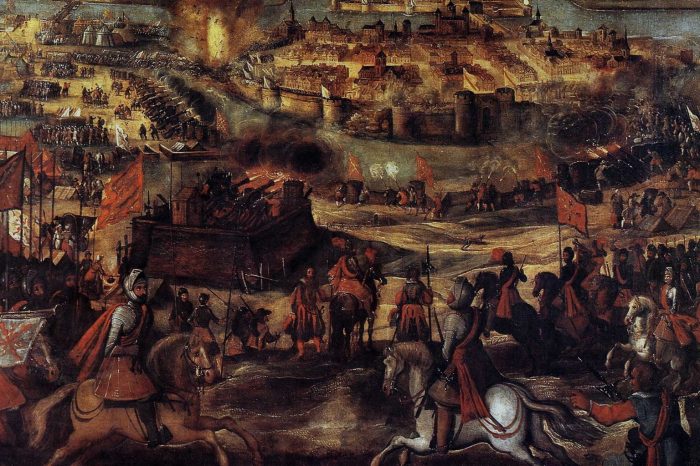Who were the malcontents in georgia – The malcontents of Georgia, a group of dissidents who emerged in the 18th and 19th centuries, played a significant role in shaping the political and social landscape of the region. Their motivations, methods, and legacy continue to resonate in contemporary discussions about dissent and resistance.
These individuals, driven by grievances against the established order, sought to challenge the authority of the government and advocate for their own interests. Their actions ranged from peaceful protests to armed uprisings, leaving a lasting impact on Georgia’s history.
Malcontents in Georgia: Who Were The Malcontents In Georgia
In the context of Georgia’s history, “malcontents” refers to a group of individuals who expressed dissatisfaction and opposition towards the established political and social order. The emergence of malcontents in Georgia can be traced back to the early 19th century, when the country was facing significant political and economic challenges.
The grievances of the malcontents stemmed from various factors, including:
Political grievances
- Dissatisfaction with the autocratic rule of the Russian Empire, which limited Georgian autonomy and suppressed political dissent.
- Resistance to the policies of the Russian administration, which were perceived as oppressive and exploitative.
Economic grievances
- Discontent with the economic policies that favored Russian interests over Georgian ones.
- Resistance to the heavy taxation imposed by the Russian government.
Social grievances
- Dissatisfaction with the social stratification and inequality that existed within Georgian society.
- Resistance to the cultural assimilation policies of the Russian Empire, which threatened Georgian identity and traditions.
The malcontents sought to address their grievances through various means, including political agitation, armed resistance, and diplomatic negotiations.
Key Figures and Groups Associated with Malcontent Activity

The malcontent movement in Georgia involved a range of individuals and organizations, each with their own motivations and goals.
Prominent Individuals
One of the most prominent malcontent leaders was Joseph Bryan, a wealthy planter and former governor of Georgia. Bryan was a vocal critic of the state’s ruling elite and led the movement for a more democratic government. Another key figure was William Few, a delegate to the Continental Congress and a signer of the Declaration of Independence.
Few was a moderate malcontent who sought to reform the government from within.
Organizations and Groups
The malcontent movement was supported by a number of organizations and groups, including the Georgia Gazette, a newspaper founded by Bryan, and the Republican Party, a political party founded by Few. The Gazette was a forum for malcontent ideas, while the Republican Party provided a political platform for malcontent candidates.
Relationships and Connections
The key figures and groups associated with the malcontent movement in Georgia were interconnected in a variety of ways. Bryan and Few were close friends and political allies, and they worked together to promote malcontent ideas. The Georgia Gazette and the Republican Party were both important vehicles for malcontent propaganda, and they were closely aligned with Bryan and Few.
The malcontent movement in Georgia was a complex and multifaceted phenomenon, and the individuals and groups involved played a significant role in its development.
Methods of Resistance and Protest
Malcontents in Georgia employed various methods to express their grievances, ranging from peaceful protests to violent uprisings. The effectiveness of these methods varied depending on the circumstances and the response of the authorities.
Non-Violent Resistance
Non-violent resistance was a common strategy among malcontents in Georgia. This included boycotts, strikes, petitions, and public demonstrations. These methods aimed to disrupt the economy, raise awareness, and pressure the government to address their demands. While non-violent resistance could be effective in mobilizing support and attracting international attention, it often faced suppression from the authorities.
Violence and Uprisings
In some cases, malcontents resorted to violence and armed uprisings. These were often a response to perceived government oppression or the failure of non-violent methods. While violence could be effective in achieving short-term goals, it often led to harsh reprisals from the authorities and alienated potential supporters.
Role of Violence vs. Non-Violence
The role of violence in malcontent activities is a complex and controversial issue. While violence can be effective in drawing attention to a cause and forcing concessions from the government, it also carries significant risks. Non-violent resistance, on the other hand, can be more sustainable and less likely to provoke a violent response from the authorities.
However, it can also be less effective in achieving immediate results.
Impact of Malcontent Activity on Georgia’s Political and Social Landscape

Malcontent activity in Georgia significantly impacted the state’s political system and social fabric. The resistance and protests spearheaded by malcontent groups brought about both short-term and long-term consequences that shaped Georgia’s political culture.
Short-Term Effects
In the immediate aftermath of malcontent activity, Georgia’s political system underwent substantial changes. The removal of corrupt officials, the implementation of electoral reforms, and the increased awareness of political rights and responsibilities among the populace were some of the notable short-term effects.
Long-Term Effects
The long-term effects of malcontent activity were equally profound. The establishment of democratic institutions, the strengthening of civil society, and the emergence of a more engaged and informed citizenry were among the lasting legacies of the malcontent movement.
Impact on Social Cohesion and Stability
Malcontent activity also had a significant impact on Georgia’s social cohesion and stability. The mobilization of diverse social groups and the articulation of shared grievances fostered a sense of unity and common purpose. However, the protests and confrontations that characterized the malcontent movement also led to tensions and divisions within society.
Influence on Political Culture
The malcontent movements in Georgia left an enduring mark on the state’s political culture. The emphasis on participatory democracy, the rejection of authoritarianism, and the demand for transparency and accountability became central tenets of Georgia’s political discourse.
Legacy and Memory of Malcontents in Georgia

The legacy of malcontents in Georgia remains a complex and contested issue today. Historical perspectives on malcontent activity have often been shaped by the political and social context of the time, while contemporary perspectives continue to be influenced by ongoing debates about the nature of dissent and the role of the state in suppressing it.
One of the most significant ways in which the legacy of malcontents is remembered in Georgia is through the commemoration of their activities and sacrifices. Memorials and monuments have been erected in honor of malcontents, and their stories are often told in schools and other public forums.
This commemoration serves to remind Georgians of the importance of dissent and the sacrifices that have been made to protect the rights of citizens.
Historical Perspectives, Who were the malcontents in georgia
Historical perspectives on malcontent activity in Georgia have varied over time. In the immediate aftermath of the malcontent movement, the government and its supporters often portrayed malcontents as traitors and rebels. However, as time passed, a more nuanced understanding of malcontent activity began to emerge.
Historians and scholars began to recognize the legitimate grievances of malcontents and the importance of their role in shaping Georgia’s political and social landscape.
Contemporary Perspectives
Contemporary perspectives on malcontent activity in Georgia are often shaped by ongoing debates about the nature of dissent and the role of the state in suppressing it. Some view malcontents as heroes who fought for the rights of citizens, while others see them as traitors who sought to undermine the stability of the state.
These differing perspectives reflect the complex and contested nature of malcontent activity and its legacy in Georgia.
Role of Memory and Commemoration
Memory and commemoration play a significant role in shaping the public perception of malcontents in Georgia. The commemoration of malcontent activities and sacrifices serves to remind Georgians of the importance of dissent and the sacrifices that have been made to protect the rights of citizens.
This commemoration also helps to ensure that the legacy of malcontents remains a part of Georgia’s collective memory and that their stories continue to be told for generations to come.
Popular Questions
Who were the key figures associated with malcontent activity in Georgia?
Prominent individuals included Elijah Clarke, John Sevier, and James Jackson, who led various uprisings and protests against the government.
What were the main grievances of the malcontents?
They objected to high taxes, land policies that favored wealthy elites, and the lack of representation in government.
How did the malcontents express their dissent?
They employed a range of methods, including petitions, protests, armed uprisings, and the formation of political organizations.